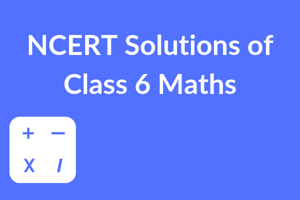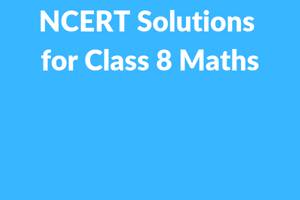Maths is an important subject that is applicable to several other academic courses. Class 6 maths...
5th Standard Maths CBSE Updated Chapters & Syllabus 2020-2021
Mathematics has been an important subject since class 1. 5th standard maths syllabus includes some crucial topics in an interesting manner. From complex equations to simple number systems and geometry to data handling, various concepts in mathematics are linked to each other. Class 5 maths syllabus briefly touches all these topics while linking them vaguely to each other.
The CBSE syllabus for 5th standard maths is however crucial in building the stepping stones for mathematics in higher classes. 5th class maths is the highest level of mathematics in junior or primary school. After this, students will move to a different level of education. Hence, certain mathematical concepts need to be embedded in their minds with a thorough understanding. 5th class maths includes many such concepts. From performing calculations and operations on numbers to understanding geometrical shapes, 5th grade maths touches many different concepts and topics of mathematics as a whole.

Let’s have a brief overview of the ncert 5th class book and various chapters it contains. The NCERT math book class 5 has 14 chapters. These chapters run through various concepts that can broadly be divided into the following categories – numbers and operations, geometry and shapes, fractions, data handling, percentage, mental arithmetic, measurement, and patterns. Here, we’ll have a chapter-wise overview of the class 5 maths syllabus as per the CBSE system.
The 14 chapters in the NCERT math book class 5 are named as follows:
Chapter 1 – The Fish Tale
Chapter 2 – Shapes And Angles
Chapter 3 – How Many Squares?
Chapter 4 – Parts And Wholes
Chapter 5 – Does it Look The Same?
Chapter 6 – Be My Multiple, I’ll Be Your Factor
Chapter 7 – Can You See The Pattern?
Chapter 8 – Mapping Your Way
Chapter 9 – Boxes And Sketches
Chapter 10 – Tenths And Hundredths
Chapter 11 – Area and Its Boundary
Chapter 12 – Smart Charts
Chapter 13 – Ways To Multiply And Divide
Chapter 14 – How Big? How Heavy?
Evident from the above titles of the chapters, the class 5 maths syllabus contains versatile topics. We’ll now look into these 5th standard maths chapters in a more precise manner. Solving some class 5 math question papers by students after revising all the chapters will help them recall and practice in a better way. Kapdec can help students by providing various interesting quizzes on class 5 maths syllabus based on the CBSE system.
Blog Contents
- 1 Chapter 1 – The Fish Tale
- 2 Chapter 2 – Shapes And Angles
- 3 Chapter 3 – How Many Squares?
- 4 Chapter 4 – Parts And Wholes
- 5 Chapter 5 – Does it Look The Same?
- 6 Chapter 6 – Be My Multiple, I’ll Be Your Factor
- 7 Chapter 7 – Can You See The Pattern?
- 8 Chapter 8 – Mapping Your Way
- 9 Chapter 9 – Boxes And Sketches
- 10 Chapter 10 – Tenths And Hundredths
- 11 Chapter 11 – Area and Its Boundary
- 12 Chapter 12 – Smart Charts
- 13 Chapter 13 – Ways To Multiply And Divide
- 14 Chapter 14 – How Big? How Heavy?
Chapter 1 – The Fish Tale
The first chapter in class 5 maths syllabus explains the geometry of different shapes. This chapter also helps students in understanding the multiplication rule for calculating the total number of objects/ fishes/ goods. All these have been explained in this chapter with the help of fishes (used to represent shape as well as a commodity). Some questions help students to identify different shapes and draw fishes using circles and triangles.
Chapter 2 – Shapes And Angles
As the name of this second chapter in the 5th standard maths book suggests, it deals with the explanation of different shapes and angles in geometry. However, it is done in a very interactive manner. The chapter will help students answer certain questions like calculating the angle between the hand and the arm in the clock, identifying the angle formed between the abdomen and a thigh, and identifying the angle made by the hands of a clock at a certain time. All these concepts are explained in a very interesting and interactive manner with the use of pictures and 3D models. This is more of an activity-based chapter than just theory.
Chapter 3 – How Many Squares?
This chapter lets students draw squares from a collection of dots in question. With questions concerning the calculation of square sides, this chapter includes a set of questions that will allow them to increase their focus on the subject. It will also give students some ideas about rectangles and measurements based on it.
Chapter 4 – Parts And Wholes
Chapter 4 of the class 5 maths syllabus is an interesting chapter dealing with the right representation and exploration of fractions and all their relations. This too is an activity-based chapter where students are asked to divide a whole model or an object into equal parts and record the fractions for parts. This chapter is full of examples demonstrating the division of one whole into many parts hence, helping students to learn the basic concepts of fractions.
Chapter 5 – Does it Look The Same?
Here, in chapter 5 of class 5 maths, the concept of patterns and shapes come into the picture. The approaches offered here are step by step instructions along with tips and tricks to promote the learning process. Briefly summarizing, the three important concepts covered in the chapter are making different types of patterns and comparing them, understanding the shapes of different patterns, and changing the position of alphabets or figures and comparing them.
Chapter 6 – Be My Multiple, I’ll Be Your Factor
As the name suggests, this chapter deals with multiples and factors. Introducing the junior students to these concepts that will run lifelong in their mathematical studies have to be interactive. Hence, this is done in a very fun and interesting manner. The important points that this chapter explains include jumping the numbers such as skipping 2 or 3 or more numbers and forming the series of it, figuring out numbers divided by 2,3 or 4, writing the multiples of a number in the sequence and finding the smallest common multiples, highest common factor, etc.
Chapter 7 – Can You See The Pattern?
The concept of patterns is elaborated in this seventh chapter of 5th standard maths. It helps students in understanding various shapes and patterns. The exercises in this chapter are very fun and interesting. It helps students in brain development by asking them to form a pattern with certain rules and limited numbers.
Chapter 8 – Mapping Your Way
To summarize the questions asked in this chapter covers topics such as finding the distance of the landmark that is closer to the river or house, relative to other observations of the area of an item when it is reduced in size, defining the shape presented in the figure and picture and how many sides there are, etc.
Chapter 9 – Boxes And Sketches
As the name suggests, this 9th chapter of the 5th standard maths syllabus introduces the students to different shapes of boxes along with their drawings and figures of an open box. This chapter can be taught more interestingly and practically with the help of live examples and demonstration using 3D models, animations, and videos. This is what Kapdec e-learning academy does with its video tutorials for a better understanding of students.
Chapter 10 – Tenths And Hundredths
This chapter tries to comprehend and compare the two statistics with examples given. Students will have concerns in this chapter about calculating the length of the tail in animals. In questions such as the line that is longest among the given two and the length of a 100 rupee coin, some illustrations will help students understand this chapter better.
Chapter 11 – Area and Its Boundary
The chapter covers topics such as measuring the various square and rectangle areas, also the difference between area and volume, and how they are measured. In this chapter, students are also driven to consider the problems and their solutions using simple algorithms. Certain techniques such as the multiplication and counting of tiles are also discussed in this chapter. Many of the topics mentioned in this chapter are about perimeter, identifying the area of different rectangles, etc.
Chapter 12 – Smart Charts
Chapter 12 of class 5 maths deals with the pictorial representation of data. Going by the name, “smart charts” help students with various diagrams demonstrating certain data visually. The students are introduced in this chapter to the knowledge that can conveniently be expressed in the form of tables. These are often used to represent the tables and solve problems with it, deducing various assumptions.
Chapter 13 – Ways To Multiply And Divide
The name of this chapter is self-explanatory. It deals with various methods of multiplication and division. Both of these operations are. basic calculations which are taught to students in early classes, However, with each grade, the knowledge of these operations is enhanced and elaborated. This chapter of class 5 maths syllabus involves many real-life examples and encourages students to use these concepts in real life.
Chapter 14 – How Big? How Heavy?
The concepts of different methods and units for weighing and measurements are an integral foundation of this last chapter NCERT math book class 5. Topics such as volumes and areas are explained with some real-life examples in this chapter.
We advise all the students to solve particular questions about the last revised chapter in the class 5 math question paper. Practicing and solving more question papers will help them boost their confidence and also have a better understanding of each topic.
.png?width=100&height=100&name=Kapdec%20Logo%20(400px).png)


